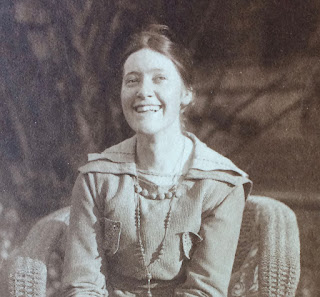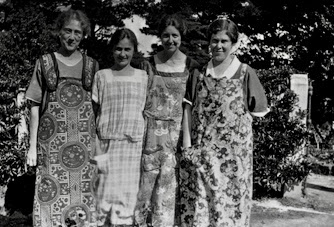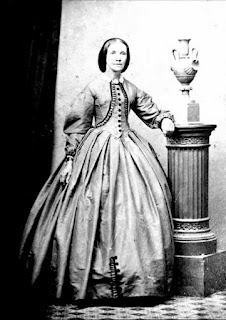18/52 Social: Margery Rebecca Godlee 1895 -1975
Social Margery Rebecca Godlee
Marge and Bill had known each other since childhood. When she was 12 her brother wrote :
In 1914, when she was 17, they got engaged.I’m surprised to hear that even a level headed parson’s son’s head was turned at the sight of your etherial (?) beauty and that he wanted to kiss you the first time he saw you. I recon that’s going the pace alright if you don’t.
Margery Rebecca was the third child of Charlotte and Theodore Godlee and was born in 1895, the same year that women in South Australia won the vote. After this her mother had another three girls and two boys. When Marge was 12 in 1908, her father died from pneumonia and then, in 1910, the baby brother also died. After that she lived in a close knit family of her widowed mother, four sisters. two brothers and Auntie Lottie, her father’s sister. They lived in a sprawling house with a big garden in College Park in Adelaide.
They had a wide and close extended family. Her mother’s Hobbs’ brothers, Uncle Harris and Uncle Frank, had market gardens just out of town. On the Godlee side there was Uncle Arthur and Aunt Eliza, who lived in Prospect with their large brood. Aunt Pollie lived in Norwood with the Burnett cousins. And then there were country family in Keith who visited from time to time, not to mention Uncle Alf. There were a lot of cousins with whom they spent beach holidays as well as regularly visiting.
As well as all this family there was the church: the Kent Town Methodist Church where Marge had met Bill Wibberley, the ‘parson’s son’ mentioned earlier. The Godlees had many friends from church. As teenagers and young people the Godlees and their friends taught in the Sunday School and joined the YWCA and Christian Endeavour. Whole families became family friends: the Lades, (another parson and his family), the Glassons, the Holders, the Casleys, (also parsons) the Rutts. These families became life long friends of the whole Godlee family. The Godlees were socially embedded in their community.
Marge had school friends too, like Dora Blair and Ann James. She went to the Adelaide Advanced School for girls, for which she had to pass an entrance exam. The school had been established in Grote Street in the 1890s to provide an academic education for girls, to prepare them to go to university. Marge did well and the December 1911 letters are full of excitement about her results. Brother John wrote:
You don’t know how pleased I was when I saw your name on the honours list. I was quite excited in fact… I see your small friend Hilda did pretty well too. Will you get one of those scholarships you were talking about when I was down? I expect you will, as you were second out of the High School.
Marge had social times over the summer holidays, often spent away from Adelaide. The summer of 1911/12 she spent in Tasmania with friends, Gwen, Carrie and Reenie. Who were they? Friends from school, church? The next summer 1912/13 she went to stay in Perth, Western Australia with Bill’s parents, Mr and Mrs Wibberley. Bill wasn’t there. In Jan 1914 she was in Adelaide because she attended the Student Christian Conference in Mt Barker, although she didn’t seem to attend as many of theses events as her sisters, Mary, Norah and Jay, who frequently travelled interstate for these Conferences. In May 1914 she and Bill got engaged and at the end of that year she travelled by ship with Bill and his Melbourne aunts, to stay again with his parents in Perth.
Marge started University in 1912 and majored in English Literature, History and French. In 1915 Bill travelled to England and France to work with the Royal Army Medical Corps on the Western Front. Many of the cousins and family friends went to the war and many of them perished: Marge’s brother, John, closet to her in age, who had written to her regularly since he left home in 1911, was killed flying over France in 1916; her younger sister Mary’s fiancé, Jack Glasson, was killed in France in 1918; cousins, Ken Hobbs, killed on the Western Front in September 1916, three months after John; Len Godlee, Len a medical orderly who died on the Western Front in June, 1917; Keith cousin, Charlie Godlee died of illness on the Western Front in Feb, 1918,. Others went and returned :Marge’s brother-in-law, Syd Holder, (married to her oldest sister Dots); Lister Godlee and Fred. It is hard to imagine living with that regular news of catastrophic events, year after year, and to know that the men you loved were still there. The women at home had to carry on.
Marge graduated and started work as a teacher. Before he died in 1916 John had written:
By the time this reaches you doubtless you will have begun your new duties as a teacher of youth. Don’t overwhelm Norks and Nell with work, will you.
And in July Bill writes:
What a time Nell and Norah must be having. I wish I could learn French that way: what a lot I would learn sitting on the lawn, in one of those comfy chairs, beside the erudite French tutor in a charming brown frock or else in a room, sharing a sofa. Then we would conjugate j’aime, tu aimes, nous aimons with osculatory demonstration to follow, to show that we know what we are talking about. What adjectives we would decline: cher, charmant, douce, tendre. What substantives we would dwell on : amour, joie, bonheur. That’s how French should be taught.
Mention of teaching ‘Norks and Nell’ suggests that Marge was teaching at Methodist Ladies College. Bill also mentions ‘beastly exams’ at the end of 1917. Bill was expecting to return at the end of 1917 but he was persuaded to stay on and laments the effect his decision will have on Marge:
And then, all because of what I said last November, you have forgone all offers of appointments for this year.
In November 1918 though it would appear that Marge has continued to teach, at Walford, although at the end of 1918 she is planning to stop:
So you are giving up the work at Walford. Well I don’t know whether to be glad or sorry.
Finally in 1919 Bill returned. It would have been complex., Following the death of Jack Glasson in 1918 BIll had said:
You know sweetheart (and I know you’ll understand me when I say this,) there are some parts of that homecoming that I rather dread. The fear that one’s real presence is going to make keener the sense of the loss of those who too might be wandering about the house and talking and laughing - but who won’t come home, - the fear too that our happiness, which I know we won’t be able to disguise, will make others feel too keenly what might have been.
Bill and Marge had not seen each other since 1915. I wonder if they were awkward with each other. Marge had been 19 when Bill left for France. Now she was 24.
They married in April of 1920 and moved to the country where Bill took up a medical practice in Tumby Bay on the east coast of Eyre Peninsular. She had never lived in the country. She was away from her large and close extended family and the community of the church, intimately connected to a man who was in some ways close but in some ways, perhaps, a stranger. Their war letters had been romantic and intellectual, discussing books and religion, quoting poetry. Now they lived the reality of physical closeness. Perhaps this early time in Tumby Bay was tender, and a time to treasure, just the two of them, learning to live together in a new way, Marge learning to keep house, Bill learning a new job. Or perhaps she struggled. She wouldn’t have told me if she had.
They lived in Tumby Bay for forty years and had four children. When she arrived in Tumby she did have one friend: Ann James who had been to the Adelaide Advanced School for Girls. Ann's brother was also related by marriage to Marge’s Hobbs’ cousins. She had become Anne McLeod and was called ‘Auntie Annie’ by the Wibberley children. Marge soon made new friends too: Mrs (Lucy) Schramm and Mrs (May) Sheehan were particular friends among many.
While 'Margery Wibberley' is not recognised in TROVE, 'Mrs Wibberley' has over a thousand entries. From 1922 she can be found opening the Methodist church bazaar, acting in a play or reciting at the school concert, playing the organ, judging the sewing or the flowers at the Yallunda Flat, the Lipson or the Port Lincoln Show, starting up a Girls Club. She became influential in Girl Guides, the Red Cross, the Tumby Bay Literary Society, the Tumby Bay Institute, the Country Women’s Association, the Ladies Methodist Guild and of course, as the doctor’s wife, the Hospital Ladies Auxiliary.
During the second world war she was involved in the Fighting Forces Comforts Fund, was organising the CWA to make clothes for refugees and camouflage nets, giving talks to CWA meetings about Russia and China, raising money for the Red Cross with the Miss Red Cross competition for example. In 1945 Margery won a prize at the Ungarra Methodist Ladies Guild Flower Show with her two lettuces. There were frequent social events held at their home, afternoon teas, farewelling a member of the community or holding meetings, or bridge evenings when ‘a tasty supper brought a pleasant evening to a close.’
My first visit to my grandparents in Tumby Bay was recorded by the Port Lincoln Times, in November 1952, when I was three months old. I do not remember that! I returned again in November 1953. My first memories of Dari are in the kitchen making the kinds of cakes and biscuits required for the ‘dainty’ afternoon teas recorded at social events in Tumby Bay.
Around 1957, according to my older sister, they left Tumby Bay and moved to Brandreth Street, Tusmore, an eastern suburb of Adelaide. Newspapers after 1954 are not accessible on TROVE. According to my sister, who being two years older than me has better memories of that time, we used to visit them there when we lived in Alice Springs. This is where most of my memories were solidified.
Afternoon tea when there were visitors at Dari’s place, was in the front room. It involved fine china cups and saucers with matching cake plates, with colourful floral designs. They were arranged on the tray-mobile which was like a double decker table on wheels which you rolled into the room from the kitchen. There would have been an embroidered cloth on which plates of cakes and biscuits were organised: either fruit cake, jubilee cake or lemon cake; melting moments or shortbread, recipes from the CWA cookbook. The tea pot, the milk in a pretty jug and the bowl of sugar cubes, with silver tongs, nestled amongst the cups and cakes. When it was all over, the used china was put on the bottom level and wheeled out to the washing up. It was quite an affair.
Marge was a seriously religious person and intensely social, although it is not a word I would necessarily associate with her, conjuring up images of party going and dancing. Having had a long look at all the TROVE entries during her life in Tumby Bay, I have had to revise my first ideas. She was very social and most of these dances, morning teas and so on were to raise money for good causes. It must have left a big hole in the life of Tumby Bay when she left. However it was Tusmore’s gain because she continued her active involvement with the local church and even in the nursing home I remember her organising groups of various kinds.
I was twenty seven when Dari died. I was very sad. Even now when Christmas carols in the supermarket make me cry, I am thinking of her.





Comments
Post a Comment